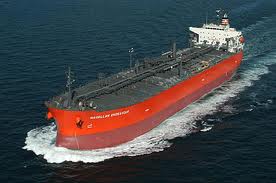
Morgan Stanley, the U.S. bank with commodity assets of about $8 billion, booked a capesize ship at what may be the lowest rent in 31 months as a glut of vessels weighed on transportation costs for raw materials.The bank hired the Anangel Explorer on
a charter of nine to 11 months at about $10,250 a day, data from Baltic Exchange Ltd. showed today. That may be the least since November 2008, when a daily rate of $6,000 was paid, according to shipbroker Clarkson Plc. The rent would be $250 a day less than the exchange reported Geneva-based SwissMarine Services SA paid this month for a charter.
"They are doing this for a long period of time to lock in a small freight rate," said Jeffrey Landsberg, New York-based president of shipping consultancy Commodore Research. "It also gives them more flexibility in their cargo trading."
Operating ships probably gives the bank better knowledge of trade flows than financial institutions that don't transport raw materials, Landsberg said. Morgan Stanley also may be able to boost profit from the rental by trading freight derivatives, he said. The contracts, known as forward freight agreements, or FFAs, are bets, or hedges, settled by the exchange's daily price assessments for 50 maritime routes.
Hugh Fraser, a London-based spokesman for Morgan Stanley, declined to comment. The bank had $1.77 billion of revenue from commodities and fixed-income trading in the first quarter, its quarterly earnings statement shows. Physical commodities on Morgan Stanley's balance sheet swelled 19 percent to $8.1 billion by March 31 from $6.8 billion at the end of 2010.
Coal Cargoes
Single-voyage capesize rents climbed 11 percent today, the most since May 19, to $9,826 a day as more ships were booked to haul iron ore and coal within the Atlantic Ocean basin, data from the exchange showed.
Capesizes are the largest vessels tracked by the Baltic Dry Index, a wider measure of raw-materials transportation costs, which rose 1.4 percent to 1,424 points. Rents dropped for the other three ship types in the gauge.
The 289-meter (948-foot) Anangel Explorer, like other capesizes, is too big to pass through the Panama Canal and must instead sail around Cape Horn or the Cape of Good Hope to deliver its cargo. The vessel has a transportation capacity of 171,925 deadweight tons. Capesizes mostly carry iron ore, a raw material for making steel.
The global capesize fleet expanded by 21 percent in the last year, outpacing demand to transport commodities at sea, according to data from the research unit of Clarkson, the world's largest shipbroker. Seaborne hauling of bulk commodities will rise 4 percent in 2011, it estimates.
Traders were betting that daily capesize rents will be $9,500 in the third quarter and $10,750 in the following three months, according to freight-derivatives prices from Clarkson brokers at 3:30 p.m. today.
Daily rents for panamax ships, the second-biggest vessel type in the index, fell 1.4 percent to $15,652. Supramaxes dropped 0.2 percent to $13,809 and handysizes slid 0.3 percent to $10,926.
Source: Alaric Nightingale, Bloomberg
We use cookies to improve your experience. By continuing to use our site, you accept our Cookies, Privacy Policy,Terms and Conditions. Close X